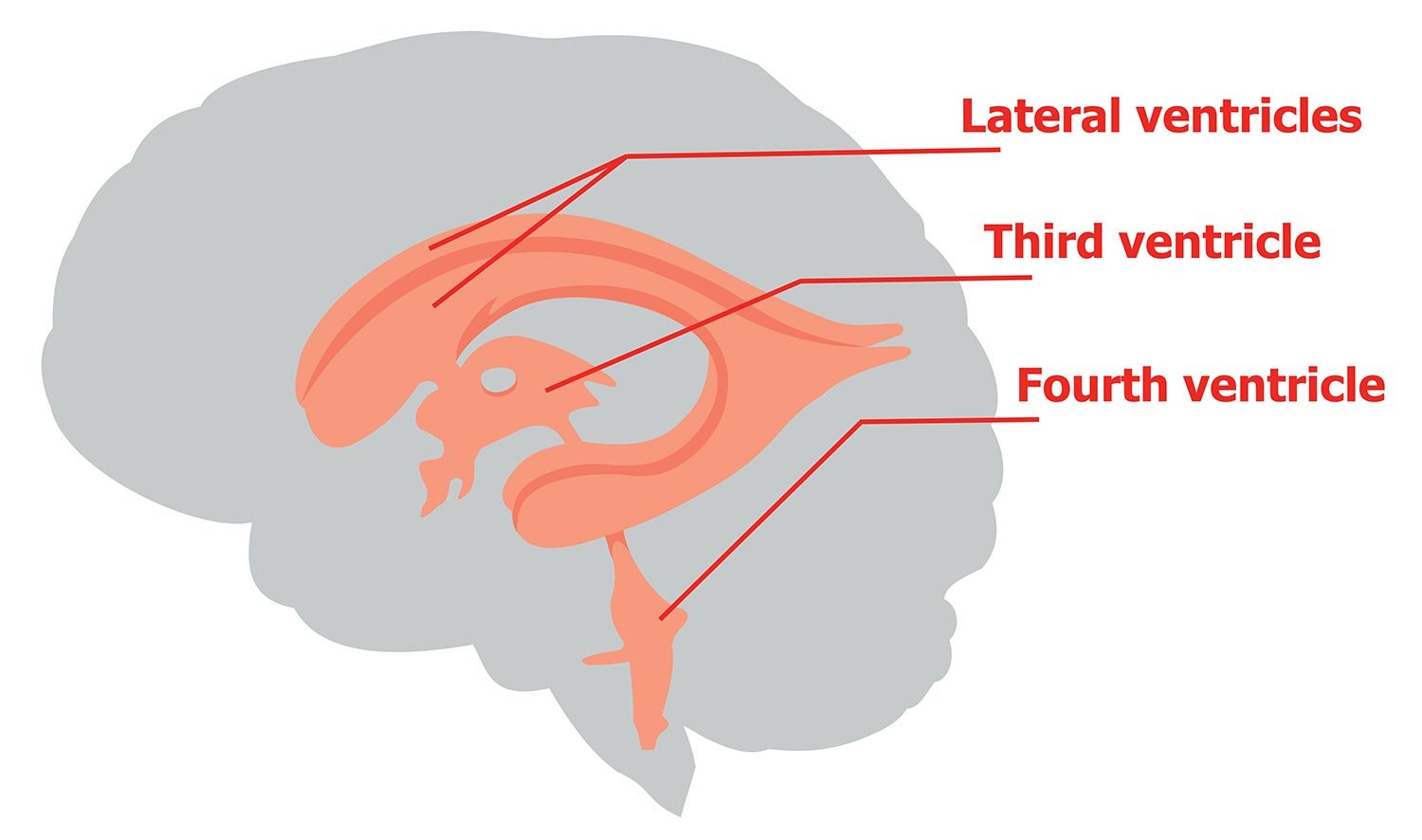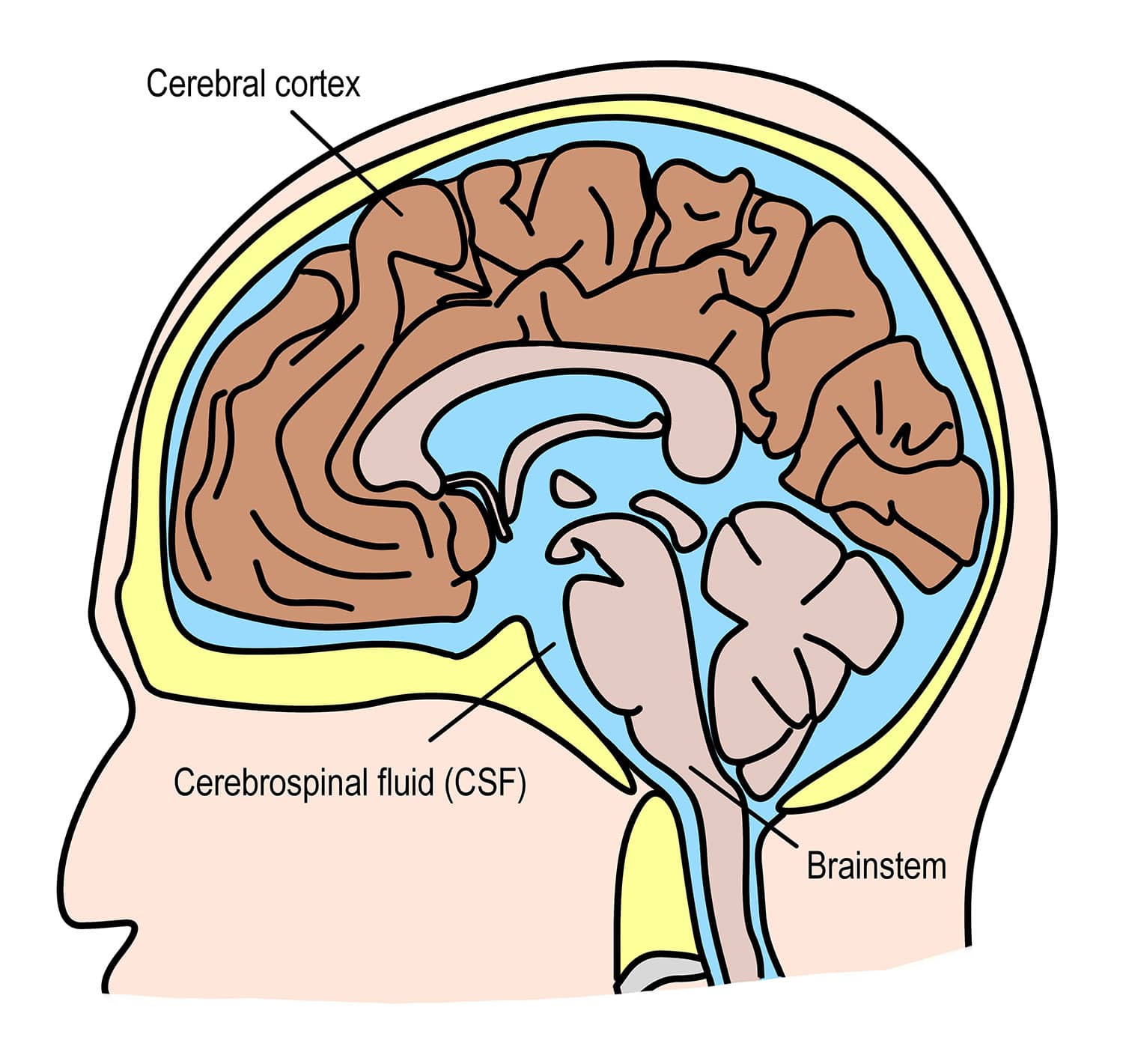The brain is one of the most complex organs in the human body, and it relies on several hidden systems to function properly. One of these is the ventricular system—a network of interconnected, fluid-filled cavities deep within the brain.
These spaces produce and circulate cerebrospinal fluid (CSF), which cushions the brain, removes waste, delivers nutrients, and maintains internal pressure.
In this article, we’ll explore the structure and function of the ventricles, how CSF works, and what happens when this delicate system goes wrong.

Key Takeaways
- The brain’s ventricular system is a network of fluid-filled cavities that produce and circulate cerebrospinal fluid (CSF).
- CSF cushions the brain, removes waste, delivers nutrients, and helps regulate pressure and temperature.
- There are four ventricles: two lateral, one third, and one fourth, all connected by narrow passageways.
- Disruption in CSF flow can lead to serious conditions like hydrocephalus, meningitis, and brain hemorrhage.
- Understanding the ventricles helps explain how the brain protects and sustains itself internally.
What are brain ventricles?
Brain ventricles are hollow structures located within the brain that contain and circulate cerebrospinal fluid. There are four ventricles:
- Two lateral ventricles (one in each hemisphere)
- The third ventricle, located at the brain’s midline
- The fourth ventricle, situated near the brainstem
These ventricles are connected by narrow passageways called foramina and the cerebral aqueduct, forming a continuous system through which CSF flows.
Although they are empty-looking spaces, ventricles are lined with a specialized membrane called the choroid plexus, made up of ependymal cells—a type of glial cell. These cells produce cerebrospinal fluid and help maintain the environment around the brain and spinal cord.
The ventricles are therefore essential for maintaining the central nervous system (CNS).

The Four Ventricles Explained
Below is further elaboration on the four ventricles:
Lateral Ventricles
These are the largest and most prominent ventricles. Each is C-shaped and located within its respective cerebral hemisphere.
They extend into the frontal, occipital, and temporal lobes. The lateral ventricles connect to the third ventricle via the interventricular foramina (foramina of Monro).
Third Ventricle
This narrow, funnel-shaped cavity lies between the left and right sides of the thalamus.
It communicates with the lateral ventricles through the foramina of Monro and with the fourth ventricle through the cerebral aqueduct (aqueduct of Sylvius).
Fourth Ventricle
The fourth ventricle sits between the brainstem and the cerebellum. Shaped like a diamond, it receives CSF from the third ventricle and releases it into two main pathways:
- The central canal, which runs down the spinal cord
- The subarachnoid space, which surrounds the brain and spinal cord
What Is Cerebrospinal Fluid (CSF)?
Cerebrospinal fluid (CSF) is a clear, water-like liquid that flows continuously through the brain’s ventricles and around the spinal cord.
It’s mainly produced by filtering plasma from the blood at the choroid plexus. On average, the human body produces about half a liter of CSF each day.
Although the brain is protected by the skull and three meninges (dura mater, arachnoid mater, and pia mater), there is still space within the skull that could allow the brain to shift or sustain injury.
CSF fills these spaces, providing additional protection and stability.

Functions of Cerebrospinal Fluid
Cerebrospinal fluid performs several vital tasks:
- Shock absorption: CSF cushions the brain and spinal cord, protecting them from sudden impacts.
- Buoyancy: By suspending the brain in fluid, CSF prevents it from collapsing under its own weight.
- Nutrient delivery: CSF transports glucose, proteins, lipids, and electrolytes to support neural function.
- Waste removal: It clears away toxins and cellular debris, which are then filtered out of the bloodstream.
- Pressure regulation: A steady flow of CSF helps maintain intracranial pressure. Disruptions can lead to dangerous pressure buildup.
- Temperature control: Circulating fluid helps maintain consistent brain temperature.
- Immune defense: CSF contains immune cells that monitor the brain for infection or damage.

How Cerebralspinal Fluid Flows Through the Ventricles
CSF is primarily produced in the lateral ventricles. From there, it follows a set pathway:
- Flows into the third ventricle via the foramina of Monro
- Moves into the fourth ventricle through the cerebral aqueduct
- Exits the fourth ventricle into:
- The central canal of the spinal cord
- The subarachnoid space around the brain and spinal cord
From the subarachnoid space, CSF is gradually reabsorbed into the bloodstream via structures called arachnoid granulations.
What Happens When the Ventricular System Fails?
Disruption in the production, flow, or reabsorption of CSF can cause serious medical issues. Below are common conditions linked to ventricular system dysfunction:
Hydrocephalus
This condition, often called “water on the brain,” occurs when CSF builds up due to blockage or poor absorption.
The ventricles swell, increasing pressure inside the skull. It can result from birth defects, infections, tumors, or head injuries. There are two types:
- Communicating hydrocephalus: CSF flow is blocked after exiting the ventricles
- Non-communicating hydrocephalus: CSF flow is blocked within the ventricular system
Symptoms vary by age:
- Infants: Enlarged head, bulging soft spot, irritability, poor feeding, sleepiness
- Adults (especially over 60): Walking difficulties, incontinence, cognitive decline
Meningitis
Meningitis is inflammation of the meninges, usually caused by infection. When bacteria, viruses, or fungi invade the CSF, they can obstruct its flow and cause hydrocephalus. Bacterial meningitis is the most dangerous form.
Symptoms include:
- Fever, headache, stiff neck
- Light sensitivity, nausea, confusion
- Seizures
Ventriculitis
This occurs when the ependymal lining of the ventricles becomes inflamed, usually due to infection, trauma, or surgery. It can mimic meningitis with symptoms like fever, seizures, and confusion.
Brain Hemorrhage
Bleeding in or around the brain—such as from a stroke, aneurysm, or trauma—can block CSF flow. Intraventricular hemorrhages may result in hydrocephalus.
Symptoms may include:
- Sudden headache, vision changes
- Slurred speech, weakness, or unconsciousness
Final Thoughts
The brain’s ventricular system may not be well known, but it plays a critical role in keeping your brain functioning safely and smoothly.
CSF provides essential support—protecting, nourishing, and cleansing the central nervous system. Understanding how this system works helps us appreciate how even small disruptions can lead to major consequences for brain health.
References
Neuroscientifically Challenged. (2015, February 1.). Know Your Brain: Ventricles. https://neuroscientificallychallenged.com/posts/know-your-brain-ventricles
Crumble, L. (2021, October 28). Ventricles of the brain. Kenhub. https://www.kenhub.com/en/library/anatomy/ventricular-system-of-the-brain
Vega, J. (2021, October 21). The Anatomy of the Brain Ventricles. Very Well Health. https://www.verywellhealth.com/brain-ventricles-3146168
Jones, O. (2020, November 13). The Ventricles of the Brain. Teach Me Anatomy. https://teachmeanatomy.info/neuroanatomy/vessels/ventricles/



